The flying Princess lands in Rö
 n the afternoon of the 1st September 1936, which was a day with low clouds, heavy
rain and high winds, a small, blue one-seat aeroplane landed in the fields close
to the farm Ticksta in Rö. Out of it jumped the Romanian princess Marina Ştirbey
and asked the gathering Rö villagers if she could borrow a telephone.
n the afternoon of the 1st September 1936, which was a day with low clouds, heavy
rain and high winds, a small, blue one-seat aeroplane landed in the fields close
to the farm Ticksta in Rö. Out of it jumped the Romanian princess Marina Ştirbey
and asked the gathering Rö villagers if she could borrow a telephone.
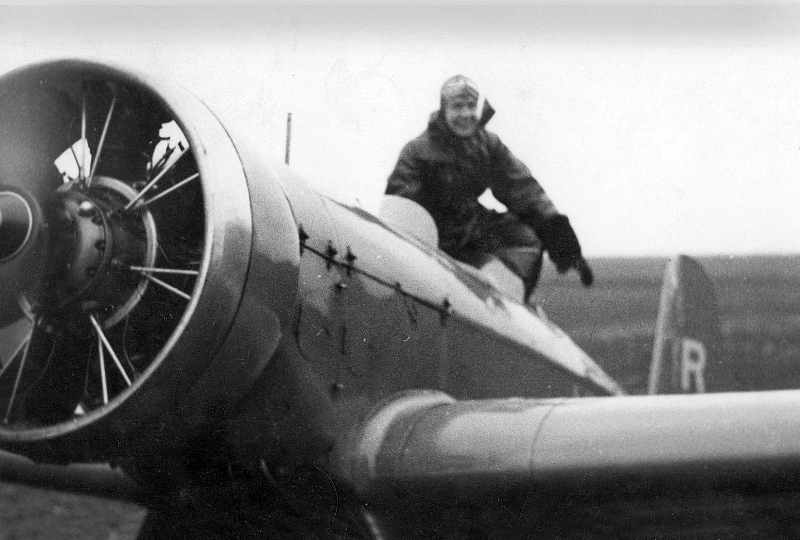
Marina jumps put of her plane – but this picture is not from Ticksta, though! Picture
courtesy Mihai Andrei.
One of those who ran to Ticksta to see was Folke Lindberg’s grandfather, David Lindberg.
When he came home again he neatly wrote in his almanac “The Romanian princess Marina
emergency landed in Rö 1st September”. The same day he bought a threshing-mill for
1700 crowns – what a day!
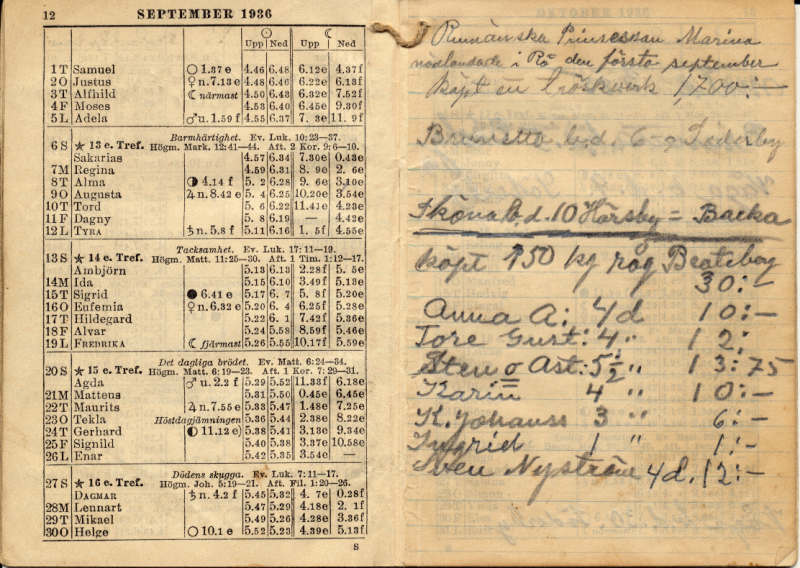
David Lindberg's almanac with the note about the Princess's landing
Christina Lindholm, Folke’s wife, observed the note this spring, and since then
we have wondered much over who this princess was, why she landed in Rö, and why nobody
seemed to know about the incident. During the summer we searched (somewhat idly)
on the Internet for a Romanian princess Marina but found nothing. In the beginning
of November, however, Christina went to the City Archive in Norrtälje and started
reading the micro-filmed archives of Norrtelje Tidning, our local newspaper. And
there she found it, in the paper of 3rd September 1936, the full story!
Under the heading ”Romanian flying princess makes emergency landing in Rö” we are
served a whole column which tells us that the princess was on a pleasure flight
from Bucharest via Vilnius, Riga, Tallinn, Helsinki and Åbo and planned to fly home
over Stockholm, Copenhagen, Berlin and Prague. In Åbo she was warned about bad weather,
but did not heed the warnings but set out over the Åboland archipelago. There the
weather not unexpectedly turned out to be awful, so she had to fly at minimum altitude
under heavy clouds in heavy rain towards Sweden. Remember she sat in an open cockpit
with only a small windshield to protect her against the elements!
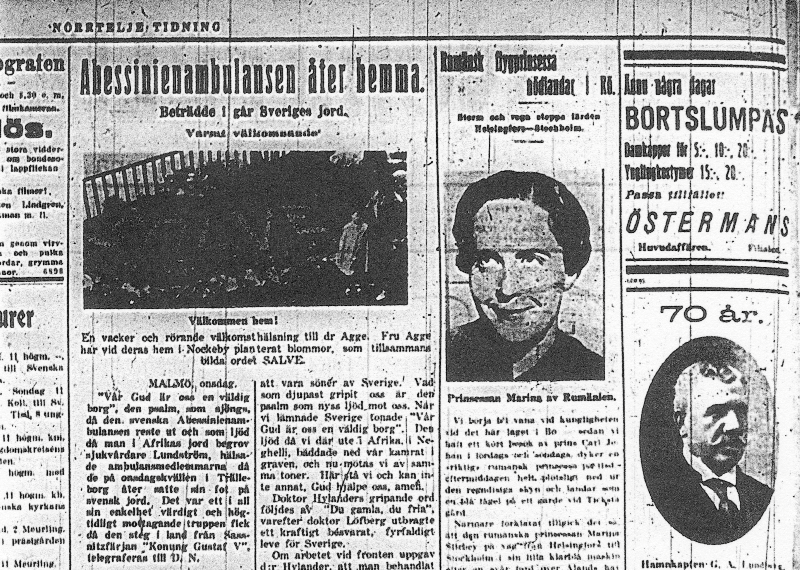
Norrtelje Tidning, 3 September1936
When she finally came in over land north of Norrtälje the weather, if possible,
became even worse, and when she had reached Rö she realised that she could not continue
flying. She made a couple of turns just over the tree tops and found the Ticksta
fields, which looked reasonably smooth and level. There she landed without any mishaps,
and jumped out of the cockpit to talk to the Rö villagers. She was shown to a telephone
to summon a car from the Romanian legation, and the villagers helped her to anchor
the plane against the storm winds. She found time to give an interview to Norrtelje
Tidning’s reporter (did he live in Rö, or how did he hear and get himself there?)
before she went to Stockholm to spend the night.
The day after she came back with the train 5.17 pm, which was a freight train –
but the station-master in Rö – his name was Johan Rundgren - found it unsuitable
for a princess to travel by freight train and convinced Train Control in Stockholm
to attach a coach wagon to the train for the princess to sit in.
After much mutual politeness between the princess and the villagers she received
a bunch of flowers from the children, climbed into the cockpit, started the engine
and rolled off over the field to get maximum start distance – and so she pushed
the throttle of her 150 hp engine and lifted off elegantly, made a few turns over
the crowd and disappeared towards Stockholm. And the Rö villagers went home, one
of them to put the decisive clue into his almanac.
When we had read the article in Norrtelje Tidning we just had to find out
who this flying princess was, and what happened to her afterwards. All answers are
there on the Internet, of course, you just have to know how to search for it – but
a little bit of luck always helps.
Eventually we found Marina Ştirbey in a Romanian online encyclopedia, ”Enciclopedia
romaniei” – which naturally, but in our case regrettably, is in Romanian. We found
someone who could help us with the translation, and after following many false trails
we could at least get a reasonable picture of who “our” flying princess was.
Then suddenly we struck gold – in a pedigree for the princely house of Craiovesti
– Brancoveni, which we also got from the Internet, we found Marina, her sons and
her grandchildren. We had no hits when we sought for the sons on the Internet (they
have simplified their names, it turned out), but Marina’s daughter-in-law was there,
with an e-mail address! So we sent her an e-mail and she confirmed that she was
actually married to Prince Mihai Brancovan and gave us his e-mail address. Another
e-mail and we had his very kind answer and a promise to send pictures and other
material, which duly arrived after a week or so.
So now we can tell the story of Princess Marina: She was born In Vienna 19th March
1912, daughter of Prince George Ştirbey and his wife Elizabeth.
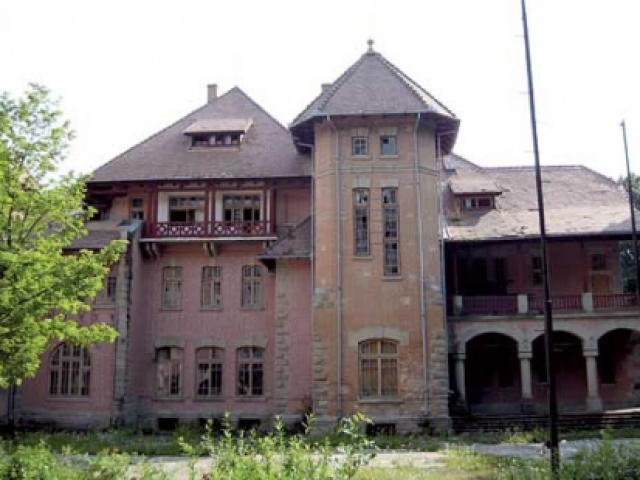
Marina’s childhood home in Dărmănesti – today sadly decayed. Picture courtesy Mihai
Andrei.
She was given a thorough and modern education, and took part in many sports – for
example she raced with her own Bugatti in car rallies. But since her family abounded
with pilots, flying became her great passion. She acquired her pilot’s certificate
in 1935 and was trained in stunt flying by her cousin Constantin Bâzu Cantacuzino,
who was a well-known stunt and fighter pilot.
In 1934 she ordered a Romanian-made copy of the German interceptor aircraft Messerschmitt
M23b. It was registered as YR-MAI, where YR means Romania and MAI means MArIna.
With this plane she participated in many air shows and competitions, and also made
her European tour, with the involuntary stop in Rö.
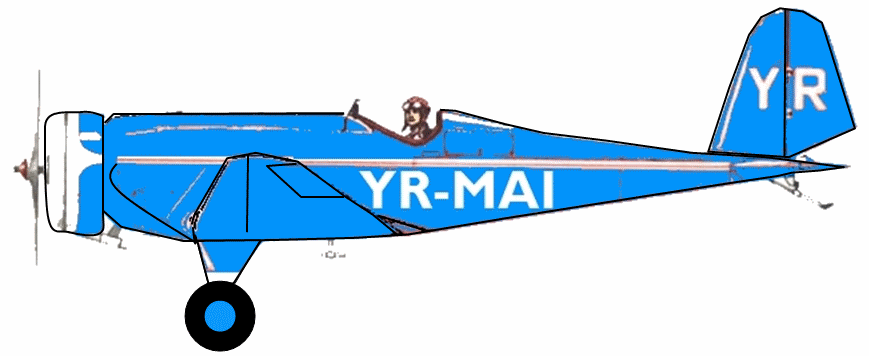
A single-seat ICAR Universal – with Marina’s colour and markings. Original picture
http://www.airwar.ru/enc/law1/icaruniversal.html
Her aircraft was the most modern Romania could produce at that time – in its normal
version it had two seats, but for Marina the forward cockpit was filled with an
extra fuel tank and covered. With the extra tank she could fly six hours at 160
km/h; so she could fly almost 1000 km without refuelling. The plane was 7 m long
and had a wing span of 12 m; with topped-off tanks it weighed 825 kg.
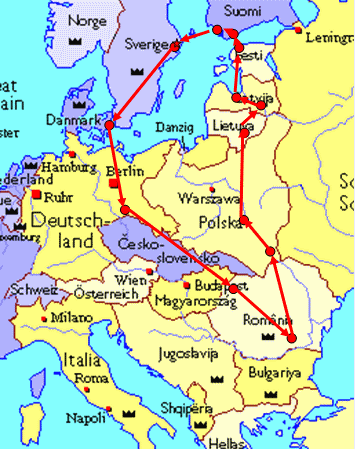
Marina's flight route on a map with the national borders of 1936. Original picture
http://users.erols.com/mwhite28/euro1935.htm
She started from Bucharest in the morning of the 29th August and planned to fly
via Cernauti (nowadays it is called Chernivtsy and lies in Ukraine) and Vilnius
to Tallinn, but was forced to land at Lvov and didn’t come farther than Vilnius
that day.
Fog and rain delayed the start 30th August, and after only an hour on her way to
Riga she again came into fog and rain and almost by coincident found an airfield
in eastern Latvia to land on, quite a bit off-track. In the afternoon the fog lifted
and she could fly on to Riga.
The next day she had intended to fly straight over the Baltic to Stockholm – she
was already delayed – but the airport in Stockholm was closed due to fog, and instead
she had to fly on to Helsinki via Tallinn.
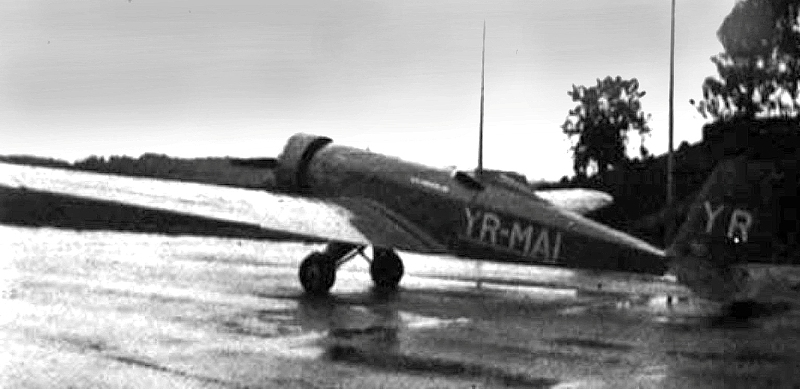
Marina's aircraft in Helsinki airport, 1 september 1936. Picture courtesy Mihai
Andrei.
On the 1st September the fog lay dense over Helsinki until 1 p.m. She started towards
Stockholm, made a stop in Åbo, and then continued towards Stockholm. She could fly
for an hour before the weather worsened again, and she had to fly just over the
sea surface. So she made landfall just north of Norrtälje – her compass doesn’t
seem to have been in perfect condition. When she estimated that she had about 50
km left to Stockholm – and that was a correct estimate – she had to make the emergency
landing in Rö, “a place with three houses and a railway station” as she later said
– the fog must have been VERY dense, because there were actually quite a few more!
The voyage home was uneventful – she had fair weather and flew home via Copenhagen,
Dresden and Arad near the border between Hungary and Romania, and landed safely
in Bucharest 6th September 1936.
During the last few years before the Second World War she continued to pursue her
flying career; she graduated as a fighter pilot, had a private airfield constructed
near the family’s castle in Dărmănesti, and flew sightseeing passengers in her new
plane, a Klemm 35.
When the war had broken out King Carol II appointed a high-ranking military as his
prime minister, but was promptly thanked by being forced to abdicate, while the
new prime minster soon set himself up as Romania’s “führer”. He allied Romania with
Germany, and as we all know that was a huge mistake.
During the war Marina was a leading person in the Red Cross of Romania, and took
the initiative to organise a flying ambulance squadron with only female personnel,
the “White squadron”. It is said that she got the idea from the Finnish “Lotta Svärd”
organisation, which also was the model for the Swedish Women’s Auxiliary Service.
The White squadron airlifted wounded soldiers from the east front, for example from
Stalingrad, and is said to have saved the lives of over 1500 soldiers. In the beginning
the aircraft were painted all white with red crosses, but the Russian fighter pilots
did not care much about the Red Cross symbols and shot at them anyway. So the White
squadron had to take leave of the colours that gave it its name and from 1941 the
aircraft were camouflage painted.
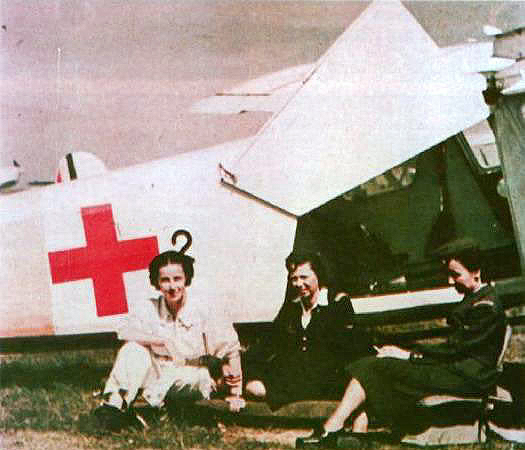
Three of the pilots of the White squadron in front of their Polish-built ambulance
aircraft model RWD-13. Picture courtesy Mihai Andrei.
Marina married, in the middle of flaming war, with Prince Constantin Basarab-Brâncoveanu,
who had a degree in Law and served in the diplomatic corps. After the wedding Marina
immediately returned to the front.
After the war, Romania became part of the eastern bloc, the communists arrested
Marina’s husband, who had to spend the years between 1948 and 1954, and again between
1959 and 1964 in prison. The régime also confiscated the family’s property, including
Marina’s aircraft, and after that she never flew herself again.
Marina and Constantin had two sons, Constantine Emanoil, born 1943 and Mihai, born
1948. The family left Romania in 1964 and first settled down in Kent, where Constantin
worked for the Romania department of the BBC in London. He died in 1983, shortly
after retiring.
The family bought a house in Bouloc in south-western France, where Marina died in
2001. Constantine Emanoil stayed in England and became professor of Russian history
at the University of Manchester. Now retired, he still lectures at the University
of Sheffield and the Columbia University in Missouri in the USA.
Mihai teaches mathematics at the Université Pierre et Marie Curie . He and his family
live in Paris, where his wife also works at another university. They have two daughters,
Iseut Marie Mathilde, born 2005, and Marie Emilie Valentine, born 2006. Mihai also
has a son Clement Constantin from an earlier marriage.
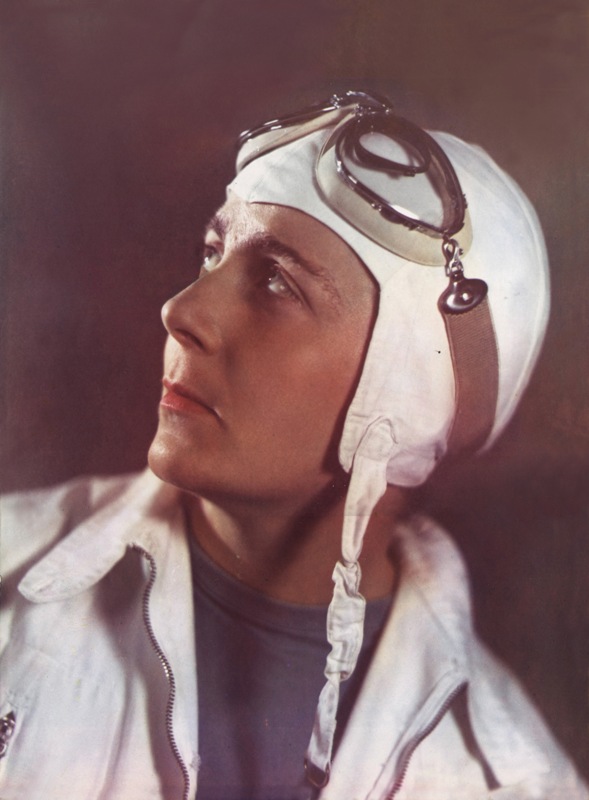
Princess Marina Ştirbey Brâncoveanu 1912 - 2001. Picture courtesy Mihai Andrei.
We sincerely thank Prince Mihai Brancovan and aviation historian Mihai Andrei who
have generoulsy shared information and pictures, Mihai Ciubotariu for his translation
from Romanian into English, and also Christina Lindholm and Urban Lindblom, who
helped us with the research.
Text: Björn & Ann Britt Bergström. Page first published 4 December 2011.